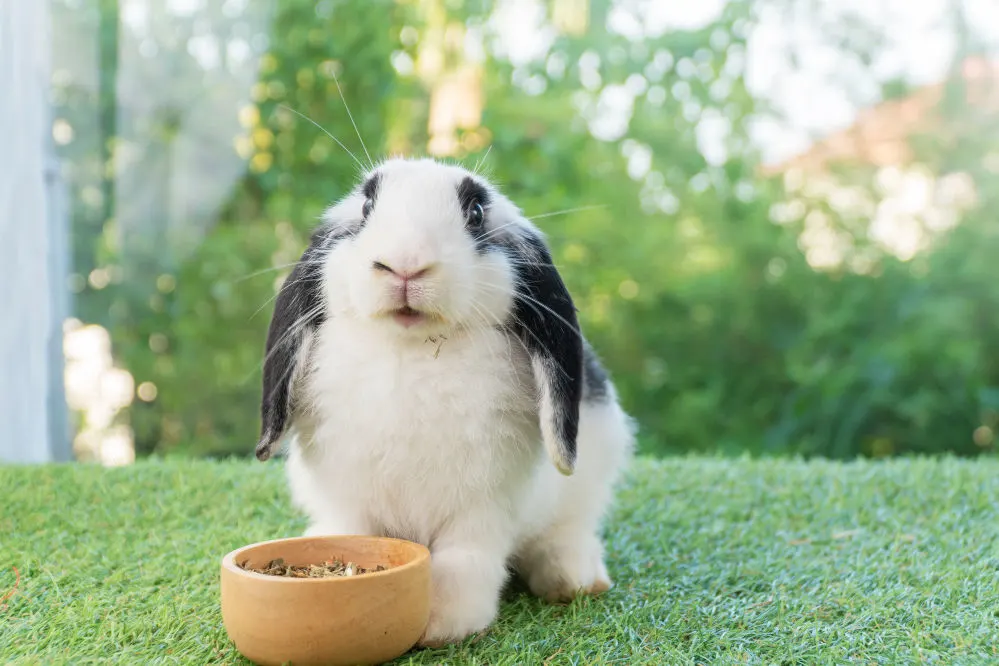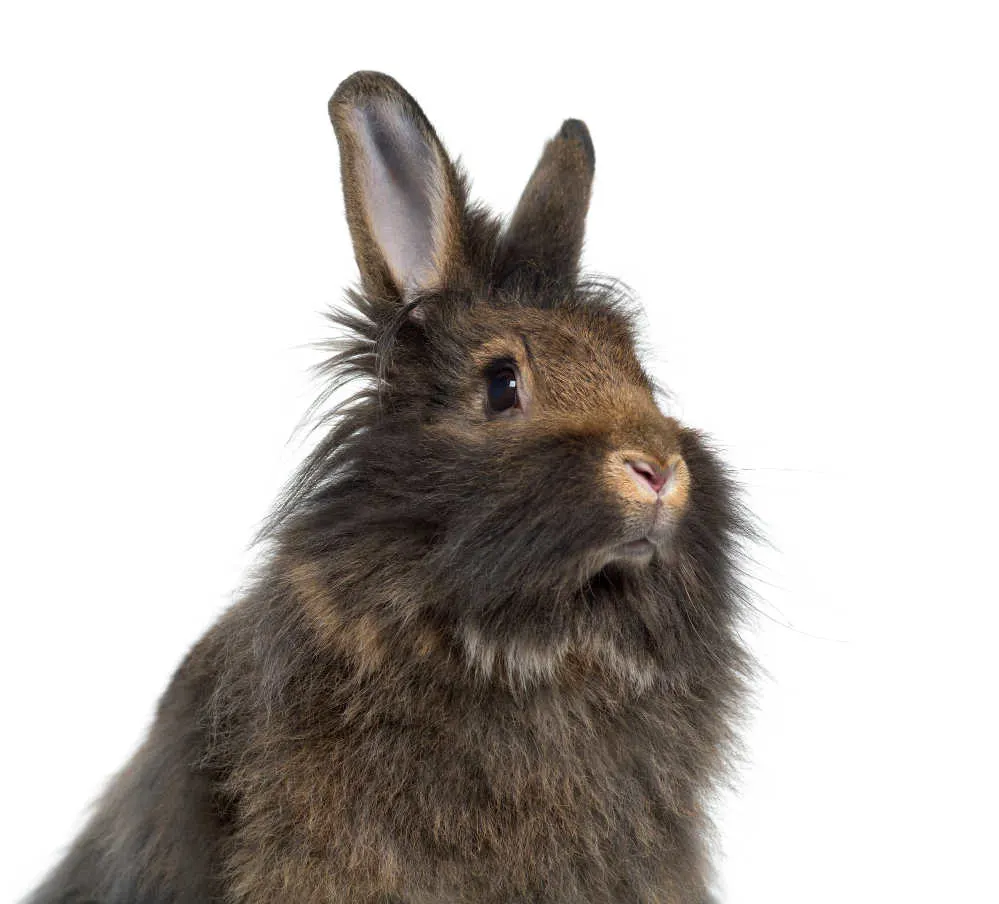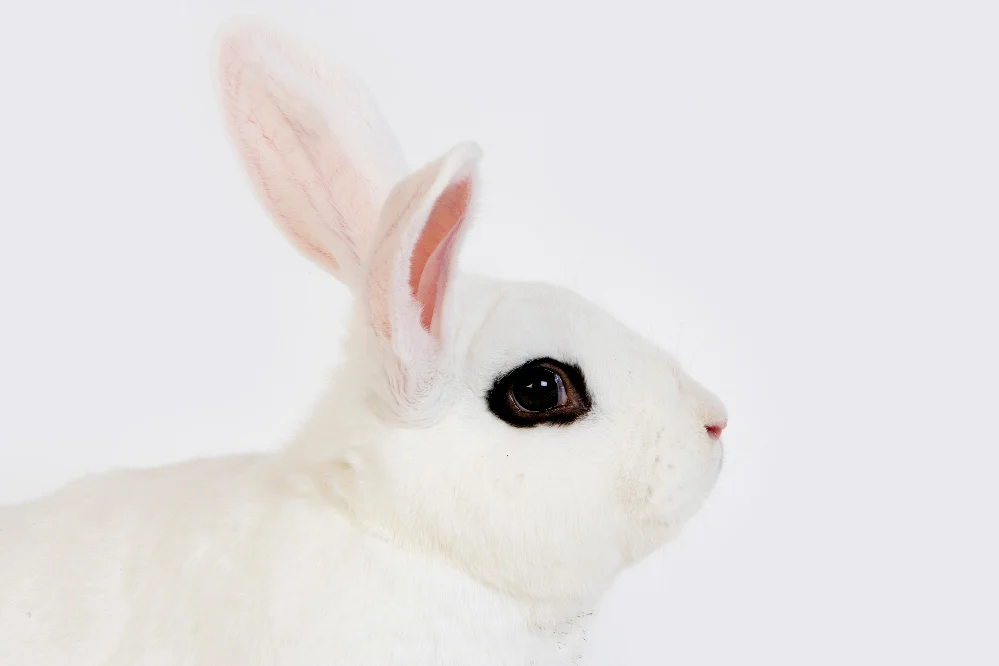Thinking of adopting a new pet rabbit? How about getting yourself the cutest, fluffiest little fuzzball? These are some of the most popular long-haired bunnies that’ll make you swoon!
The American Rabbit Breeders Association (ARBA) recognizes 50 distinct bunny breeds, but we’ll focus on the hairy bunch for now. From playful Angora breeds to cuddly Mini Lops, you’re sure to find your next soul bunny — so keep reading.

Not only will you get to know these amazing long-haired breeds, but you’ll also learn some grooming tips and ways to take care of your fuzzy bun.
16 best long-haired rabbit breeds
Apart from their lush, shiny manes, we’ll also look at each long-haired breed’s characteristics, size, and temperaments. Let’s hop in.
1. Lionhead rabbits
Lionheads are cute little bun-buns that resemble, you’ve guessed it, a lion — thanks to a majestic mane encircling its head. You might think these small rabbits are aggressive due to their appearance, but they’re quite the opposite. Lionheads are kind, gentle, and playful.
They shed quite a lot to keep up with their mini-lion facade and require a lot of space to play and hop about. Weighing no less than four pounds (1.8 kg) in adulthood, these happy buns thrive on human interaction, a healthy diet, and regular grooming.

With a lifespan of seven to nine years, these are great pets to have around — just don’t leave them unattended with small children, as they are delicate.
2. Holland Lops
The Holland or Dutch Lop is a fantastic long-haired bunny for anyone who doesn’t mind daily grooming. These floppy-eared cutie pies sit on the small size of the scale weighing between two – four pounds (0.9 – 1.8 kg) in adulthood.
Holland Lops are suitable for children and active adults as they are lively, perky, and enjoy attention. Dutch Lops can live between seven to 10 years on a healthy diet, and despite needing daily brushes, they are generally easy-going buns.

They should be easy to care for, making them good pets for first-time owners. The only major concern would be a nasty inherited dental disease that could rack up the vet bills.
3. Mini Lops
Of all the different breeds, the Miniature Lop (aka Mini Lop) might be the cutest and friendliest. These long-haired rabbits are affectionate, love to cuddle, and enjoy human company.
You’ll notice them by their floppy ears, cute button noses, and large round eyes resembling a stuffed animal. They’re also pretty intelligent and cheerful, weighing no more than 4.5 to 6.5 pounds (two – 2.9 kg).

Mini Lops sport dense coats that come in different colors with short, stocky bodies and wide hinds. You can groom their beautiful coats once per week and clean their long ears every other week to prevent wax build-up. They are perfect for smaller homes and can live between seven to 14 years on a proper diet.
4. Angora rabbit
Angora rabbit breeds (or English Angora rabbits) are one of the oldest domesticated bunnies specifically bred for their long coats, known as Angora wool. These wooly rabbits are gentle, playful, and intelligent. They enjoy playing with toys and do not like being handled, but they’ll still cuddle up to their owners occasionally.

Angora rabbits are medium to large and will grow between 4.4 – 12 pounds (two – 5.5 kg). These fluffy buns have a life expectancy of seven to 12 years. The Angora rabbit can be shaved, starting from one to three months, when their hair is about three or five inches long (7.6 – 12.7 cm). However, they will naturally shed their long fur every four months.
Groom your Angora rabbit daily as they cannot groom themselves adequately, leading to matts and, eventually, skin infections.
5. French Angora rabbits
The French Angora is the second largest breed weighing roughly 7.5 – 10.5 pounds (3.4 – 4.7 kg). This rabbit is bred for show, its wool, and to be kept as pets. French Angoras are laid-back, easy-going, and gentle, suitable for inactive owners who enjoy peace and quiet.

Being such a large size with a long coat of Angora wool means this bunny needs lots of space and daily grooming. These fluffy creatures look like massive balls of cotton candy with adorable flat faces and pointy upright ears. These bunnies have a dense undercoat and seriously soft fur that’ll be incredibly soothing to run your hands across.
6. American Fuzzy Lop
The American Fuzzy Lop will make your heart melt! They are a perfect blend of the Holland Lop and the Angora, with droopy ears and soft, glossy fur. That said, daily grooming and ear cleaning every other week is highly recommended.
Otherwise, this easy-going, sweet-tempered rabbit should be a breeze to look after. They are social, active, and fun to have around the house. These bunnies are ideal for children and active adults as they enjoy playing with their owners and chew toys.

American Fuzzy Lops have a five to eight-year average lifespan, weighing about three to four pounds (1.3 – 1.8 kg). Watch out for wool blocks (or hairballs) with this small rabbit breed.
7. Cashmere Lops
Cashmere Lops are the sweetest medium-sized breed of rabbit with long, thick fur. Weighing no more than four to five pounds (1.8 – 2.2 kg), these floppy-eared hoppers are cheerful, intelligent, and active. They can also live between eight to 12 years and require enough space to play around.

These cuties were distinguished from another dwarf rabbit breed for the first time in 1980 by the British Rabbit Council. Cashmere Lops can suffer from ear infections due to wax build-up, as with most Lop breeds.
8. Harlequin rabbits
Harlequin rabbits are the clowns of their breed, not for their personality, but because of their unique coloration and markings resembling a clown. Originating in France, these oddly colored buns are fun, playful, and smart.

You’ll need to provide them with fresh food, water, and enough space for regular playtime. Apart from a fancy-looking coat, you’ll notice that the Harlequin rabbit is well-muscled, weighing about 6.5 to 9.5 pounds (two to three kg).
These rabbits make wonderful pets living up to five – 10 years on a healthy diet. You can get away with grooming this bunny at least once per week, so they’re lower maintenance than most breeds on this list.
9. Netherland Dwarf rabbits
The Netherland Dwarf rabbit is one of the cutest and best long-haired bunnies. They are small enough for compact homes and have an impressive average lifespan of eight to 15 years. They hardly grow bigger than two – 2.5 pounds (0.9 – 1.13 kg), so you must be extra careful handling these teeny buns.

You’ll feel tempted to pick them up for a cuddle, but they don’t like being handled, so approach them gently. They are calm and tame and shouldn’t be too much maintenance aside from dental disorders due to having small heads. You can identify the Netherland Dwarf rabbit by its heart-melting neotenic appearance with tiny ears, small button noses, and a flat forehead.
10. Giant Angora rabbit
By now, you know that Angora rabbits are among the fluffiest out there with the most dreamy locks. The Giant Angora, however, takes things to new heights by being the largest of its type, according to ARBA. Weighing in at roughly 4.4 to 12 pounds (2 – 5.4 kg), these mega hops require lots of space and adequate grooming.
Ever seen a bunny resembling a round poofy cloud? That would be this giant rabbit with extra long locks to add to its flair. These majestic fluffy spheres can live seven to 11 years.

Pay special attention when picking them up, as they have weak spines. Otherwise, Giant Angoras are docile, clever and enjoy playing with cat toys of all things.
Read Next: Speaking of huge rabbits, why not see how big Flemish Giants can get?
11. Satin Angora rabbit
Here’s another Angora rabbit with super soft fur, a cute face, and a lovely personality for an indoor pet bunny. Satin Angora rabbits may not have as much wool as their other Angora family members, but they require the same amount of shearing, plucking, and combing.
Their wool is also finer, and you’ll notice that these bun-buns have shorter fur on their faces, ears, and feet. Satin Angoras have an average lifespan of seven to 12 years, growing to a medium-sized weight of about 6.5 – 9.5 pounds (2.9 – 4.3 kg).

Try to visit the vet at least once per year if you have a Satin Angora, as they’re at risk of Fly Strike due to matting and GI stasis because of excessive fur ingestion.
12. Swiss Fox rabbit
The Swiss Fox rabbit is a rare breed in the United States, yet highly sought after for its beauty and splendid temperament. A Swiss Fox is cuddly, calm, and friendly, making them one of the best options for long-haired rabbit breeds. Similar to Angora and Havana rabbits, you should be hands-on regarding grooming.

These rabbits are also playful, requiring ample space to hop around as part of their daily exercise. The Swiss Fox weighs between 5.5 – 7.5 pounds (2.5 – 3.4 kg) with an average lifespan of five to eight years.
Without proper grooming, these bunnies will swallow too much of their long hair leading to digestive issues that are possibly life-threatening.
13. Havana rabbits
The Havana rabbit was first bred in 1898 in the Netherlands, with most of them having darker coats such as chocolate, black and blue. These rabbits are calm and friendly, known for their gentle and social nature.
You’ll spot this breed by their small heads, full, round cheeks, medium-sized eyes, and short straight legs. Havana rabbits typically weigh between 4.5 and 6.5 pounds (two – 2.9 kg) and have an average life expectancy of five to eight years.

They are ideal pets and show rabbits because of their docile temperament. Given a proper diet of mainly grass hay and dark leafy greens, they should be easy to look after.
14. Jersey Wooly rabbit
If its name hasn’t given it away, the Jersey Wooly is an adorable pocket-sized bun-bun with a soft coat and tiny erect ears. Having them around will light up your day since they’re sweet-natured, affectionate, playful, and intelligent.
In fact, their nickname, “No-Kick Rabbit,” is a testament to how gentle they are. They’re also affectionately called “mug heads” because of their small, flat foreheads.

Jersey Wooly rabbits can live between seven to 10 years, weighing around one – 3.5 pounds (0.4 – 1.6 kg) — which is teeny. Like the Holland Lops, these bunnies are prone to dental diseases due to a tiny skull.
15. Blanc de Hotot
A Blanc de Hotot is a gorgeous medium-sized rabbit originally bred in France in the 1900s. It has a small, compact body type with long white fur and black rings around each eye, giving it a distinct appearance. These rabbits are docile, friendly and thrive on attention from their owners and chewy toys, of course.
Since they’re so laid-back, you don’t have to be super hands-on with them. Blanc de Hotot rabbits usually weigh around eight to 11 pounds (3.6 – five kg). On a proper diet and in a healthy environment, these bunnies can have a long lifespan of seven to 10 years.

They have no breed-specific health concerns but may suffer from common conditions in rabbits, like urinary cancer and diarrhea.
16. Himalayan rabbits
Himalayan rabbits are a calm breed that enjoys human interaction, being handled, and won’t bite or scratch. These medium-sized rabbits have a striking appearance with various colors on their points and a shiny white coat on the rest of their body. They aren’t too active but can live a full life of up to eight years on a healthy diet.

These rabbits typically weigh around three to four pounds (1.3 – 1.8 kg), requiring regular grooming with a sturdy brush at least once weekly. Himalayan rabbits have only a few health issues on a proper diet and are fantastic companions thanks to their docile nature.
Caring and grooming for long-haired rabbits
Here are a few tips and tricks to help you look after your precious long-haired bunny.
Grooming tips for wooly rabbits
- Brush your long-haired rabbit daily to avoid mats, tangled fur, and large clumps.
- Do not use scissors to remove mats, as rabbit skin is delicate and prone to cuts.
- Use a mat splitter or rake to help undo mats.
- Don’t forget that next to no grooming of your rabbit can be dangerous and fatal in some cases. Undergrooming leads to a condition known as “wool/hair block,” which is essentially a blockage in the gastrointestinal tract.
- Always clean their soiled fur, as Fly Strike in rabbits is a potentially fatal condition.
- Only bathe your bun if it’s desperately needed. Otherwise, they should be able to keep themselves clean.
Diet tips for rabbits with long hair
Hay is an essential part of a rabbit’s diet and should make up about 80% of their daily food intake. Ensure your bunny has unlimited access to high-quality grass hay such as Timothy, orchard, and Brome.
Besides hay, a daily intake of fresh veggies such as romaine lettuce, celery, and bok choy are required to maintain a healthy diet. Finally, you can provide your pet with high-quality pellets every day and fresh fruits twice or thrice weekly.
Long-haired buns require more protein than breeds with short hair to help them grow their glorious manes. Hay like alfalfa, lespedeza, and Timothy are excellent sources of protein for rabbits.
Read Next: Can rabbits have strawberry tops?
Housing tips for long-haired rabbits
Rabbits with long hair need more space than breeds with short coats. The hutch should be at least four times bigger than the size of your rabbit. It’s important to provide your bunnies with the right environment, enough space, and no loud noises.

Pro Tip: Use hay as the bedding for your long-furred baby instead of wood shaving, as these can get tangled up in their fur.
Read Next: Check out these adorable rabbit house ideas to give you more insight on which hutch to choose.
Most popular rabbit breeds with long fur wrapped up
There you have it. Which one of these fluffy, long-haired rabbits did you enjoy reading about the most? They are all super cute and will probably drive you up the wall with their shedding, but it’s all worth it the moment you run your hands along their soft, silky fur.
Next Read: When do rabbits sleep?
Steph Dyson is a travel journalist by trade but a lover of all small pets. She’s been a pet mum to everything from gerbils to guinea pigs, rabbits to hamsters, and fish to dogs of all shapes and sizes. She wants to share her years of experience with small pets and make Small Pet Guides the go-to website for pet owners seeking information and care advice.

